Effect of Protrusions on the Falling Film Flow and Heat Transfer of Oily Wastewater Outside an Elliptical Tube
Abstract
1. Introduction
2. Materials and Methods
3. Case Description and Solution Method
3.1. Physical Model and Boundaries
3.2. Grid System and Independence Validation
3.3. Model Validation
4. Results
4.1. Spatiotemporal Evolution of Falling Films over Enhanced Elliptical Tubes
4.2. The Influence of Protrusion Position on Heat Transfer Performance
4.3. Influence of e and Re on Heat Transfer Performance
4.3.1. Impact of Re
4.3.2. Impact of e
4.4. The Effect of the Number of Protruding Structures on Heat Transfer
5. Conclusions
- (1)
- In the optimized design of the elliptical tube, the location of the protrusion outside the tube should be taken into account, so that when intervening in the liquid film flow outside the tube at an early stage, the disturbance effect of the protrusion on the liquid film flow can be used to accelerate turbulent mixing inside the liquid film and reduce the thermal resistance; this approach thereby more rapidly and effectively enhances the convective heat transfer intensity on the outer surface of the tube and improves the overall heat transfer performance at an early stage.
- (2)
- The heat transfer performance of enhanced elliptical tubes is strongly dependent on the number of protrusions on the tube exterior. As the number of protrusions increases, the heat transfer performance exhibits a non-monotonic trend, first increasing and then decreasing. For an ellipticity of e = 1, Model 07 exhibits the highest heat transfer performance.
- (3)
- Research on enhanced elliptical tubes revealed that different external enhancement elements exert divergent effects on heat transfer performance as the Re increases. At e = 0.5, the heat transfer coefficient decreases with rising Re. This behavior is primarily due to the more intense flow disturbances induced by the enhancement elements at higher Re, which result in substantially increased flow resistance and energy dissipation, ultimately diminishing the overall thermal efficiency.
- (4)
- The geometric parameters of protruding structures significantly influence fluid flow and heat transfer enhancement in elliptical tubes. When the perimeter of the protrusions is held constant, their effect on heat transfer is negligible at Re = 400. At Re = 600 and Re = 800, the heat transfer efficiency decreases with increasing ellipticity e. In contrast, under higher-Re conditions, the elliptical tube with e = 1 exhibits optimal heat transfer performance.
Author Contributions
Funding
Institutional Review Board Statement
Informed Consent Statement
Data Availability Statement
Conflicts of Interest
Nomenclature
| Greek characters | |||
| a | semi-major axis of an elliptical rough structure, mm | θ | Circumferential angle, ° |
| b | semi-minor axis of an elliptical rough structure, mm | l | liquid phase density, kg·m−3 |
| g | gravity acceleration, m·s−2 | g | gas phase density, kg·m−3 |
| hθ | local heat transfer coefficient, kW·m−2·K−1 | μl | liquid phase dynamic viscosity, Pa·s |
| have | average heat transfer coefficient, kW·m−2·K−1 | μg | gas phase dynamic viscosity, Pa·s |
| Re | Reynolds number | Γ | liquid film flow per unit length on one side of tube wall, kg·m−1·s−1 |
| q | heat flux, kW·m−2 | δ | liquid film thickness, mm |
| Tin | liquid inlet temperature, K | surface tension coefficient | |
| H | liquid film distributor height, m | free surface curvature, m−1 | |
| P | pressure, Pa | The protrusions positions correspond to the angles, | |
| t | times, s | ||
| surface tension, N | |||
| e | Length–width ratio, e = b/a | ||
| Tw,θ | Temperature of the tube wall at the circumferential angle θ | ||
| Tθ | Temperature of the falling film at the circumferential angle θ | ||
References
- Ribatski, G.; Jacobi, A.M. Falling-film evaporation on horizontal tubes—A critical review. Int. J. Refrig. 2005, 28, 635–653. [Google Scholar] [CrossRef]
- Dai, Z.; Zhang, Y.; Wang, S.; Nawaz, K.; Jacobi, A. Falling-film heat exchangers used in desalination systems: A review. Int. J. Heat Mass Transf. 2022, 185, 122407. [Google Scholar] [CrossRef]
- Wang, J.; Chen, X.; Lu, T.; Chen, X.; Shen, S.; Liu, B. Three-dimensional film thickness distribution of horizontal tube falling film with column flow. Appl. Therm. Eng. 2019, 154, 140–149. [Google Scholar] [CrossRef]
- Zhao, C.Y.; Qi, D.; Ji, W.T.; Jin, P.H.; Tao, W.Q. A comprehensive review on computational studies of falling film hydrodynamics and heat transfer on the horizontal tube and tube bundle. Appl. Therm. Eng. 2022, 202, 117869. [Google Scholar] [CrossRef]
- Maliackal, A.K.; Ganesan, A.; Mani, A. Heat transfer enhanced surfaces for horizontal tube falling film evaporator characterized using laser interferometry. Appl. Therm. Eng. 2022, 210, 118303. [Google Scholar] [CrossRef]
- Ubara, T.; Asano, H.; Sugimoto, K. Falling film evaporation and pool boiling heat transfer of R1233zd(E) on thermal spray coated tube. Appl. Therm. Eng. 2021, 196, 117329. [Google Scholar] [CrossRef]
- Jige, D.; Miyata, H.; Inoue, N. Falling film evaporation of R1234ze(E) and R245fa on a horizontal smooth tube. Exp. Therm. Fluid Sci. 2019, 105, 58–66. [Google Scholar] [CrossRef]
- Wang, W.S.; Wang, T.; Peng, Y.; Shangguan, S.S. Numerical Simulation on Falling Film Heat Transfer Characteristics of R113 inside Vertical Tube. J. Eng. Therm. Energy Power 2017, 32, 1–8. [Google Scholar] [CrossRef]
- Ji, W.T.; Zhao, E.T.; Zhao, C.Y.; Zhang, H.; Tao, W.Q. Falling film evaporation and nucleate pool boiling heat transfer of R134a on the same enhanced tube. Appl. Therm. Eng. 2019, 147, 113–121. [Google Scholar] [CrossRef]
- Qiu, Q.G.; Jiang, W.G.; Shen, S.Q.; Zhu, X.J.; Mu, X.S. Numerical investigation on characteristics of falling film in horizontal-tube falling film evaporator. Desalination Water Treat. 2015, 55, 3247–3252. [Google Scholar] [CrossRef]
- Zhang, Y.; Wang, D.; Liu, Y.; Tang, M.; Zhang, S. Distribution characteristics of falling f ilm thickness around a horizontal corrugated tube. Int. J. Heat Mass Transf. 2020, 154, 119773. [Google Scholar] [CrossRef]
- Xua, L.; Wang, S.; Wang, Y.; Ling, Y. Flowing state in liquid films over horizontal tubes. Desalination 2003, 156, 101–107. [Google Scholar] [CrossRef]
- Chen, X.; Shen, S.; Wang, Y.; Chen, J.; Zhang, J. Measurement on falling film thickness distribution around horizontal tube with laser-induced fluorescence technology. Int. J. Heat Mass Transf. 2015, 89, 707–713. [Google Scholar] [CrossRef]
- Qi, C.H.; Feng, H.J.; Lv, H.Q.; Miao, C. Numerical and experimental research on the heat transfer of seawater desalination with liquid film outside elliptical tube. Int. J. Heat Mass Transf. 2016, 93, 207–216. [Google Scholar] [CrossRef]
- Zhao, C.Y.; Ji, W.T.; Jin, P.H.; Zhong, Y.J.; Tao, W.Q. Hydrodynamic behaviors of the falling film flow on a horizontal tube and construction of new film thickness correlation. Int. J. Heat Mass Transf. 2018, 119, 564–576. [Google Scholar] [CrossRef]
- Tahir, F.; Mabrouk, A.; Koç, M. Impact of surface tension and viscosity on falling film thickness in multi-effect desalination (MED) horizontal tube evaporator. Int. J. Therm. Sci. 2020, 150, 106235. [Google Scholar] [CrossRef]
- Li, M.; Lu, Y.; Zhang, S.; Xiao, Y. A numerical study of effects of counter-current gas flow rate on local hydrodynamic characteristics of falling films over horizontal tubes. Desalination 2016, 383, 68–80. [Google Scholar] [CrossRef]
- Ji, G.; Wu, J.; Chen, Y.; Ji, G. Asymmetric distribution of falling film solution flowing on hydrophilic horizontal round tube. Int. J. Refrig. 2017, 78, 83–92. [Google Scholar] [CrossRef]
- Fiorentino, M.; Starace, G. Numerical investigations on two-phase flow modes in evaporative condensers. Appl. Therm. Eng. 2016, 94, 777–785. [Google Scholar] [CrossRef]
- Bajalan, S.; Kouhikamali, R.; Rahimian, M.H. Experience on horizontal-tube falling-film evaporation simulation by lattice-Boltzmann method. Heat Transf. 2019, 48, 2676–2699. [Google Scholar] [CrossRef]
- Mu, X.; Shen, S.; Yang, Y.; Liu, X. Experimental study of falling film evaporation heat transfer coefficient on horizontal tube. Desalination Water Treat. 2012, 50, 310–316. [Google Scholar] [CrossRef]
- Yang, L.; Liu, Y.; Yang, Y.; Shen, S. Microscopic mechanisms of heat transfer in horizontal-tube falling film evaporation. Desalination 2016, 394, 64–71. [Google Scholar] [CrossRef]
- Zhao, C.Y.; Ji, W.T.; He, Y.L.; Zhong, Y.J.; Tao, W.Q. A comprehensive numerical study on the subcooled falling film heat transfer on a horizontal smooth tube. Int. J. Heat Mass Transf. 2018, 119, 259–270. [Google Scholar] [CrossRef]
- Edahiro, K.; Hamada, T.; Arai, M.; Hirao, Y. Research and development of multi-effect horizontal tube film evaporator. Desalination 1977, 22, 121–130. [Google Scholar] [CrossRef]
- Hao, J.; Xu, Y.; He, T.; Mao, N.; Song, M.; Tang, J. Numerical study on heat transfer of oily wastewater spray falling film over a horizontal tube in a sewage source heat pump. Int. J. Heat Mass Transf. 2019, 142, 118423. [Google Scholar] [CrossRef]
- Zhang, Z.; Lu, H. A numerical study on fluid flow and heat transfer characteristics of oily wastewater falling film outside an elliptical tube. Int. Commun. Heat Mass Transf. 2023, 148, 107004. [Google Scholar] [CrossRef]
- Cao, G.; Zhang, Q.; Zhang, S.; Liu, G.; Feng, R.; Cui, H.; Tian, W.; Ding, K.; Hu, Z.; Zhang, X. Experimental study on the effect of tube surface modifications and in-channel baffle plates on falling film evaporator heat transfer properties for sever cabinets. Int. Commun. Heat Mass Transf. 2024, 158, 107943. [Google Scholar] [CrossRef]
- He, X.; Li, Z.; Wang, J.; Yu, H. Effects of tube cross-sectional shapes on flow pattern, liquid film and heat transfer of n-pentane across tube bundles. Chin. J. Chem. Eng. 2023, 60, 16–25. [Google Scholar] [CrossRef]
- Zhang, H.; Liu, J.; Li, Y.; Zhou, Y. Experimental and numerical investigation on the temporal and spatial distribution of liquid film thickness over a half-oval tube. Energy Build. 2023, 296, 113402. [Google Scholar] [CrossRef]
- Nemati, H.; Moradaghay, M.; Moghimi, M.; Meyer, J. Natural convection heat transfer over horizontal annular elliptical finned tubes. Int. Commun. Heat Mass Transf. 2020, 118, 104823. [Google Scholar] [CrossRef]
- Silk, E.A.; Kim, J.; Kiger, K. Spray cooling of enhanced surfaces: Impact of structured surface geometry and spray axis inclination. Int. J. Heat Mass Transf. 2006, 49, 4910–4920. [Google Scholar] [CrossRef]
- Lu, H.; Lu, L. CFD simulation of liquid desiccant dehumidifier performance with smooth and rough plates. Int. J. Refrig. 2021, 124, 1–12. [Google Scholar] [CrossRef]
- Åkesjö, A.; Gourdon, M.; Jongsma, A.; Sasic, S. Enhancing industrial vertical falling film evaporation through modification of heat transfer surfaces–an experimental study. Chem. Eng. Process.-Process. Intensif. 2023, 191, 109456. [Google Scholar] [CrossRef]
- Lee, S.; Köroğlu, B.; Park, C. Experimental investigation of capillary-assisted solution wetting and heat transfer using a micro-scale, porous-layer coating on horizontal-tube, falling-film heat exchanger. Int. J. Refrig. 2012, 35, 1176–1187. [Google Scholar] [CrossRef]
- Bock, B.D.; Meyer, J.P.; Thome, J.R. Falling film boiling and pool boiling on plain circular tubes: Influence of surface roughness, surface material and saturation temperature on heat transfer and dryout. Exp. Therm. Fluid Sci. 2019, 109, 109870. [Google Scholar] [CrossRef]
- Cao, C.; Xie, L.; He, X.; Ji, Q.; Zhao, H.; Du, Y. Numerical study on the flow and heat-transfer characteristics of horizontal finned-tube falling-film evaporation: Effects of liquid column spacing and wettability. Int. J. Heat Mass Transf. 2022, 188, 122665. [Google Scholar] [CrossRef]
- Zhao, C.Y.; Wu, J.D.; Wang, G.D.; Qi, D.; Jiang, J.M. Numerical study of falling film flow and heat transfer on the horizontal tube with a porous coating layer. Int. J. Heat Mass Transf. 2024, 221, 125046. [Google Scholar] [CrossRef]
- Zhao, C.Y.; Guan, Q.; Wang, G.D.; Yu, T.; Zhang, F.F.; Qi, D.; Liu, Q.; Jiang, J.M. Falling film dehumidification performance on plates with various enhancing elements. Phys. Fluids 2025, 37, 012113. [Google Scholar] [CrossRef]
- Meng, S.; He, Z.; He, T.; Mao, N. Improvement in heat transfer and flow pattern of sprayed falling on horizontal tubes with rib structure for a sewage source heat pump. Int. J. Therm. Sci. 2024, 208, 109431. [Google Scholar] [CrossRef]
- Hou, H.; Bi, Q.; Ma, H.; Wu, G. Distribution characteristics of falling film thickness around a horizontal tube. Desalination 2012, 285, 393–398. [Google Scholar] [CrossRef]
- Parken, W.H.; Fletcher, L.S.; Sernas, V.; Han, J.C. Heat transfer through falling film evaporation and boiling on horizontal tubes. J. Heat Transf. 1990, 112, 744–750. [Google Scholar] [CrossRef]

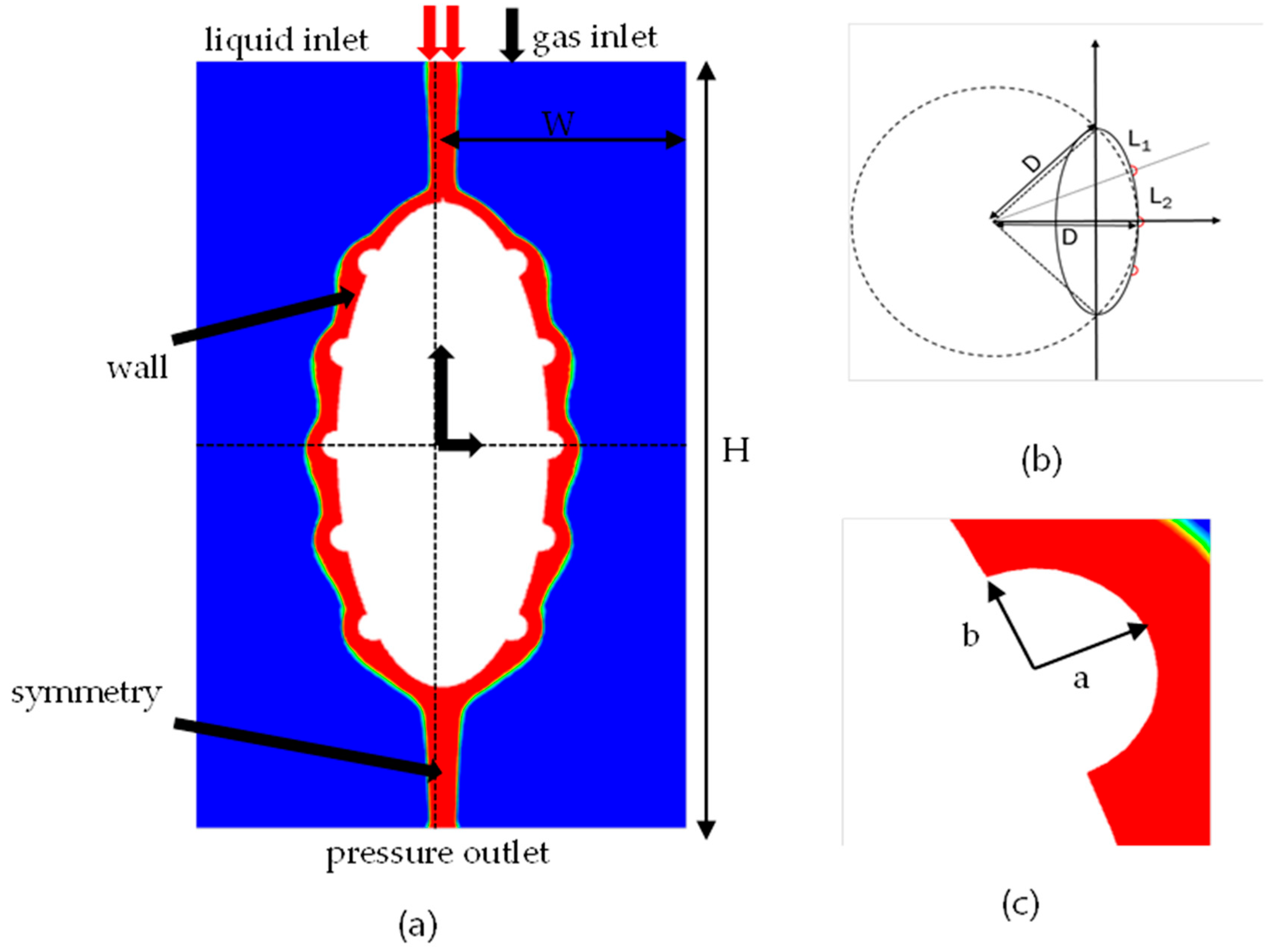
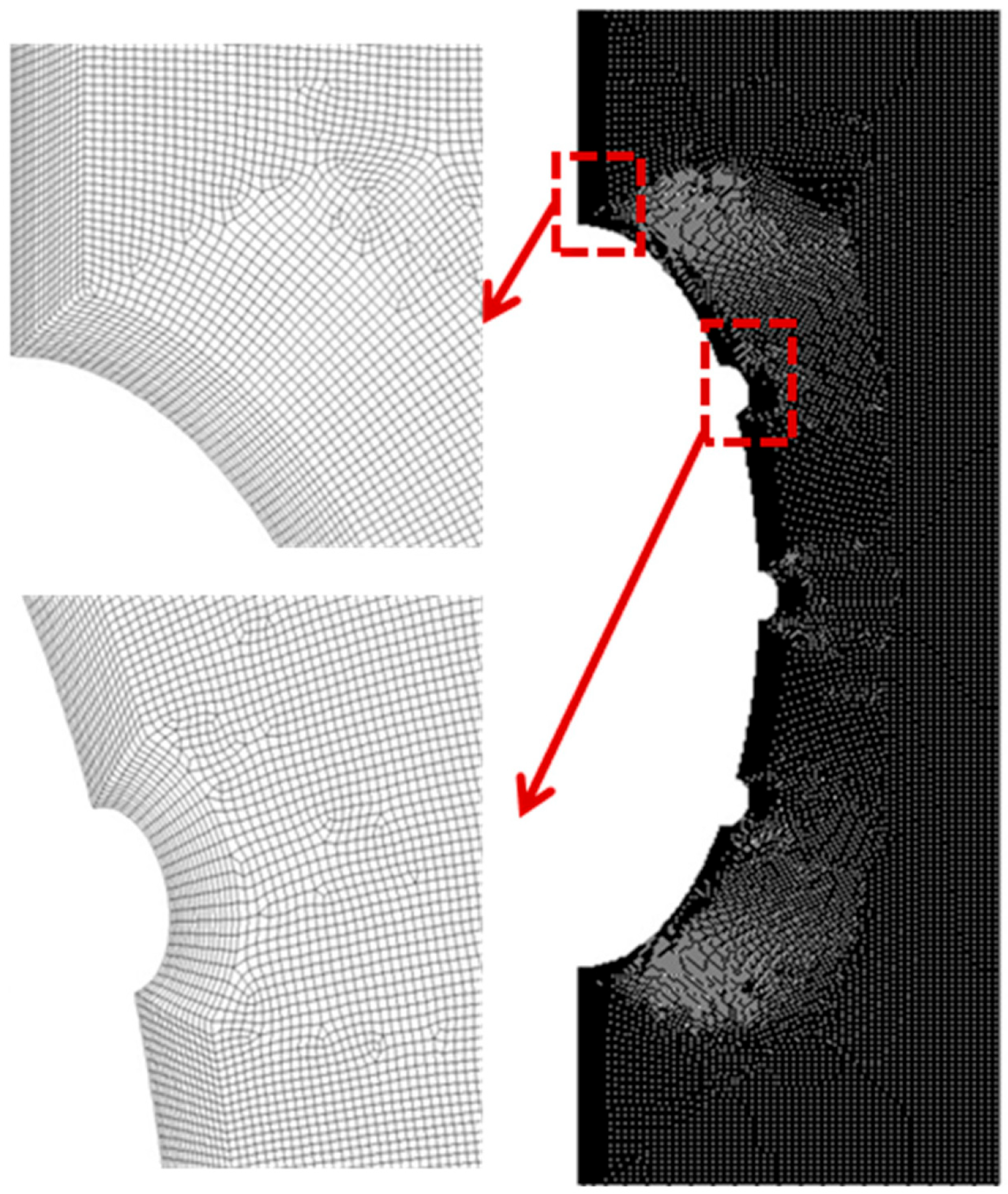

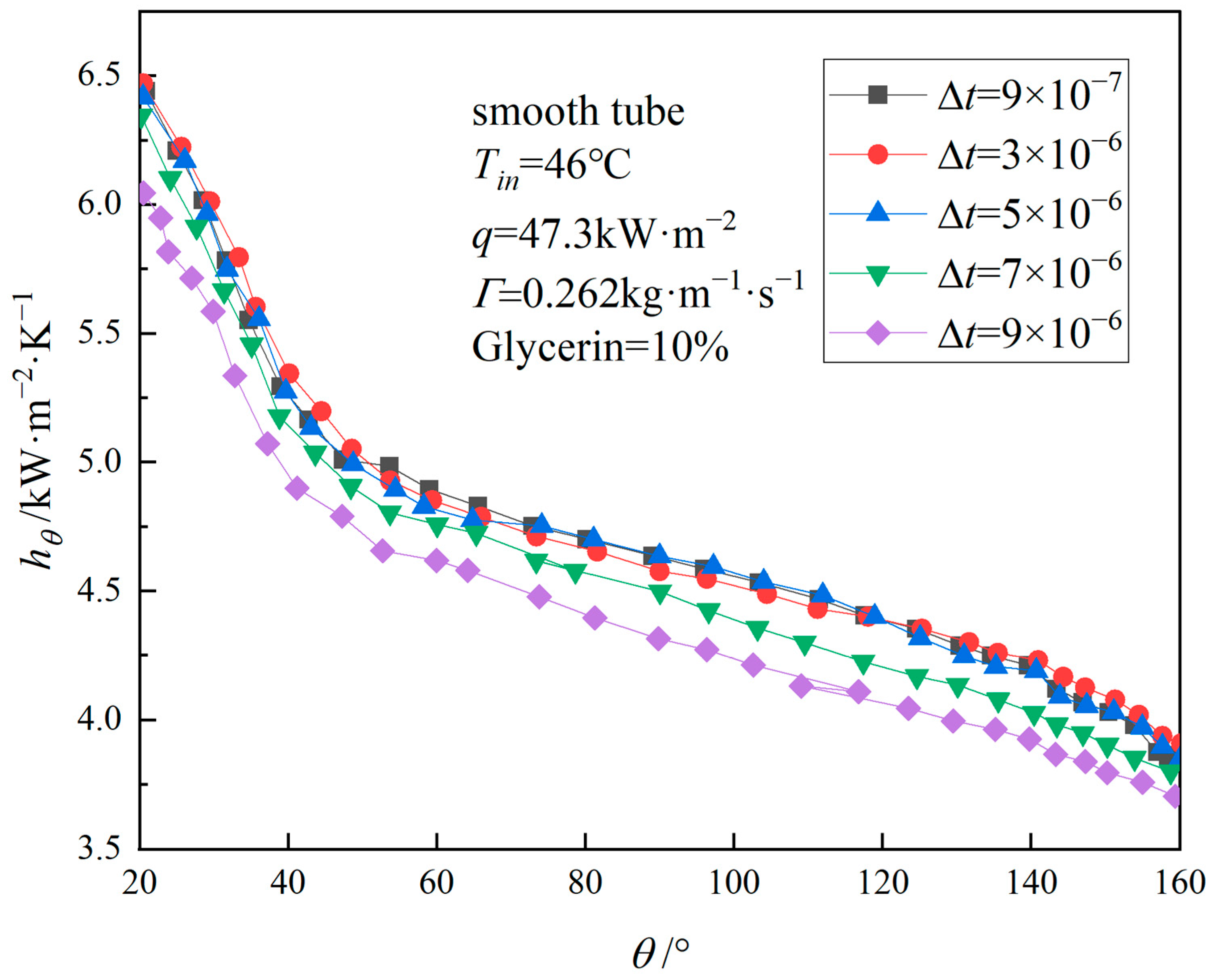


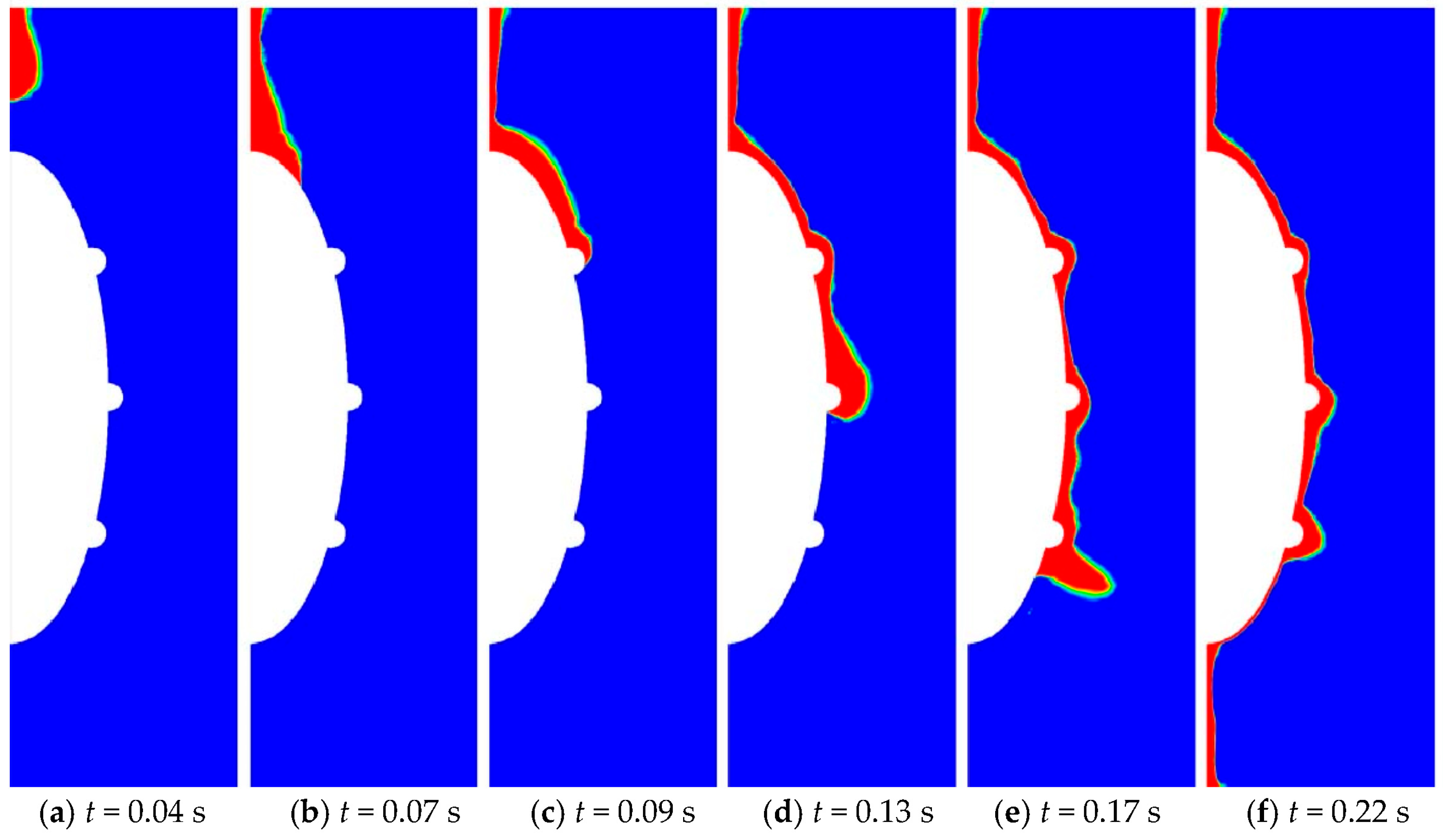
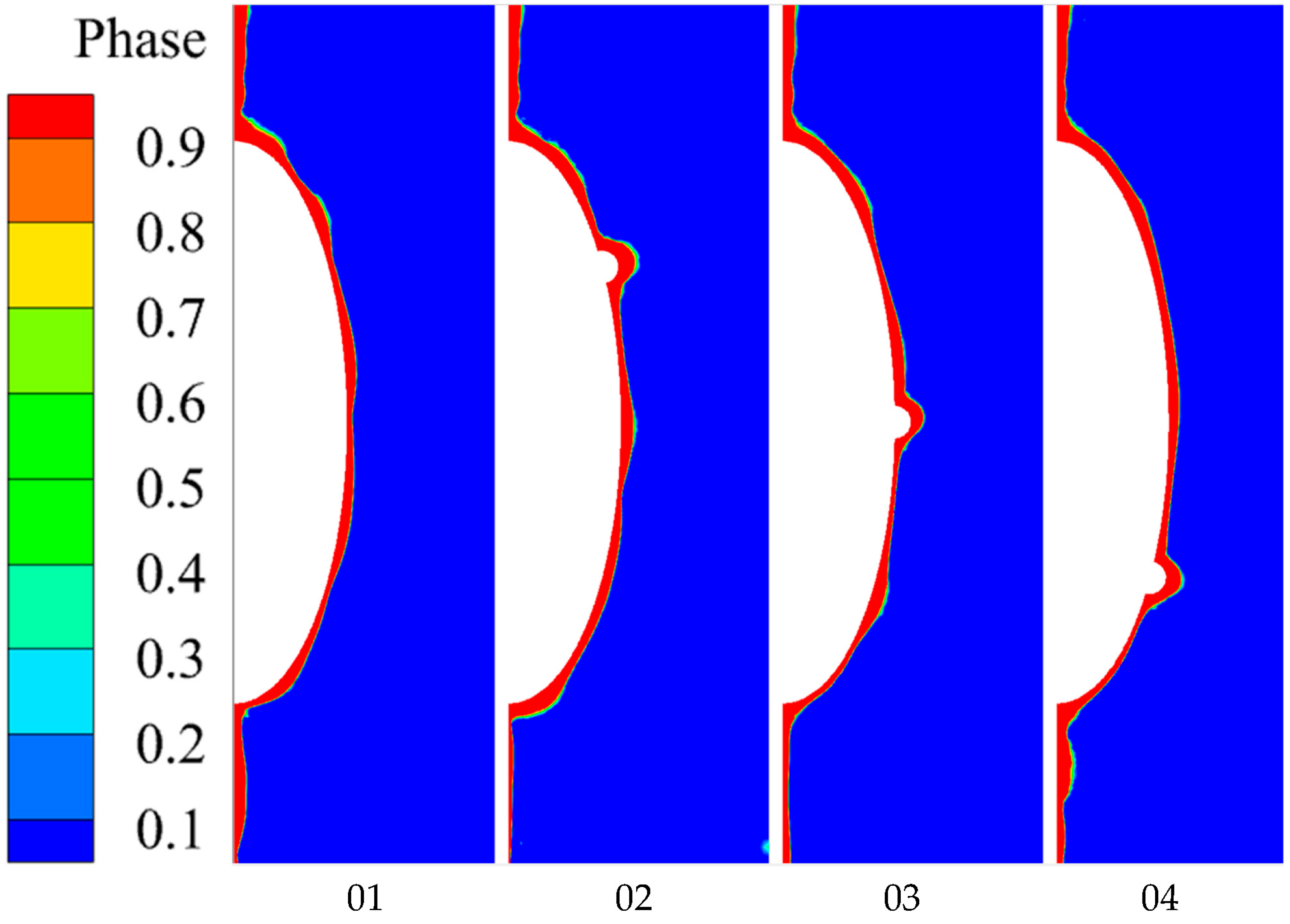
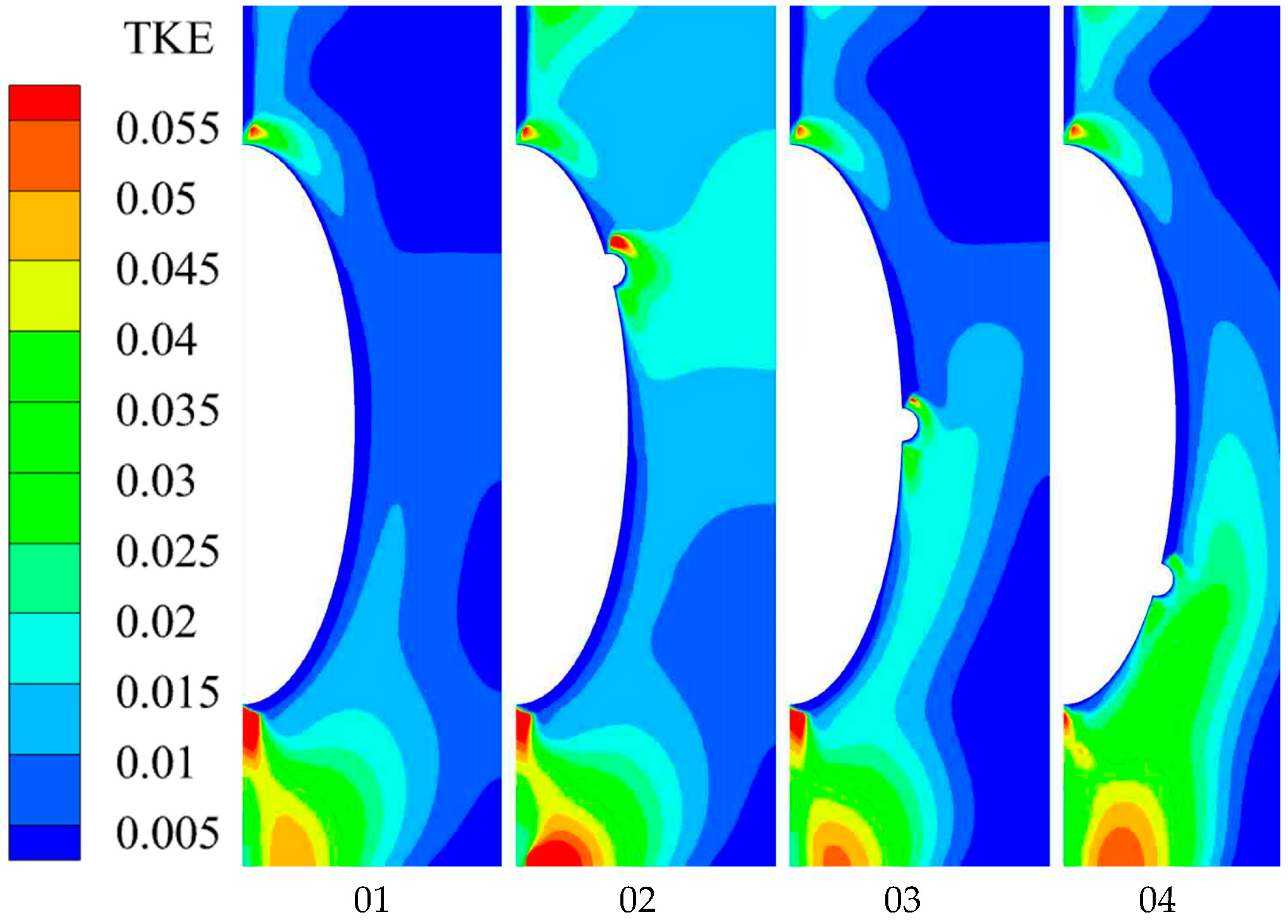

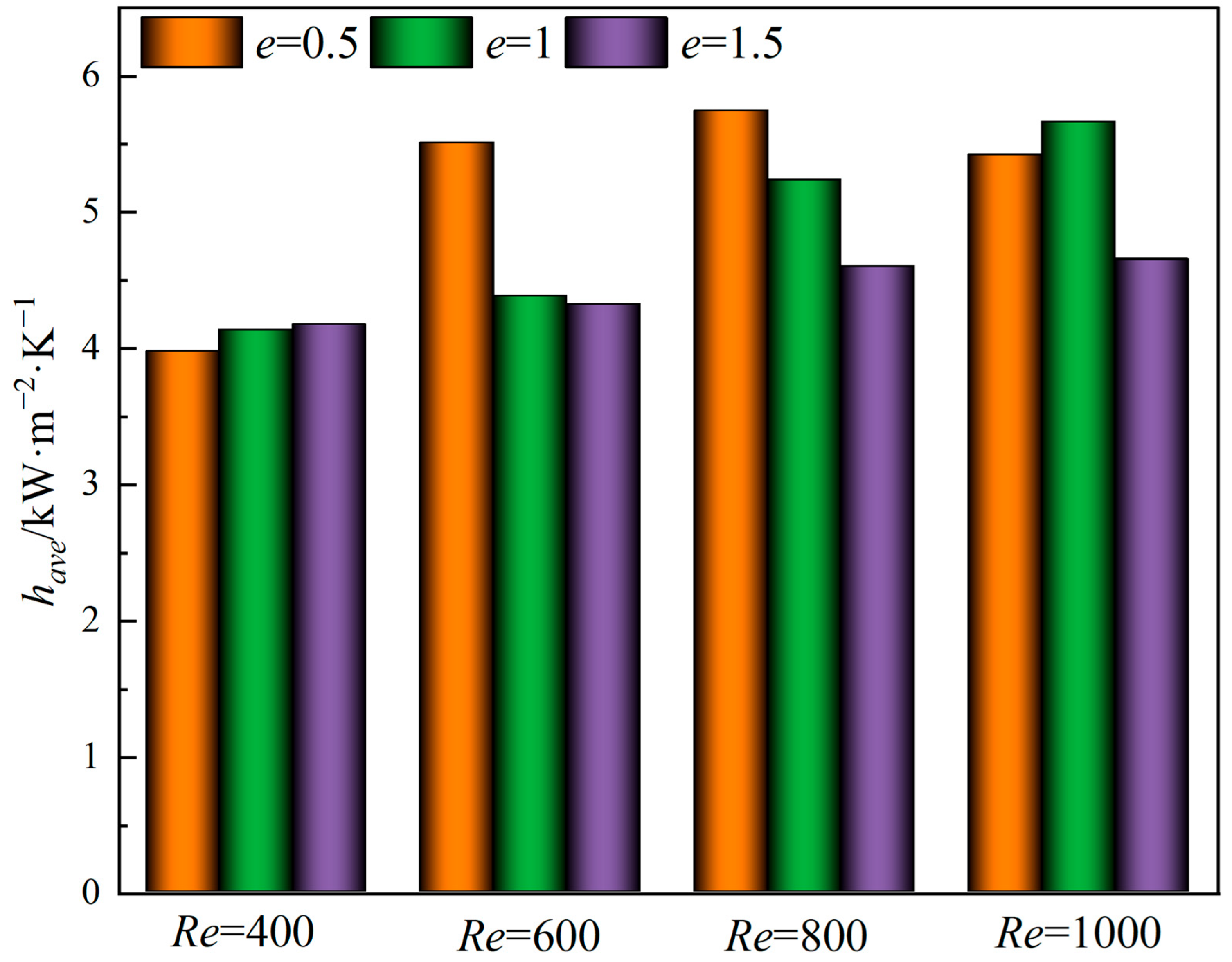
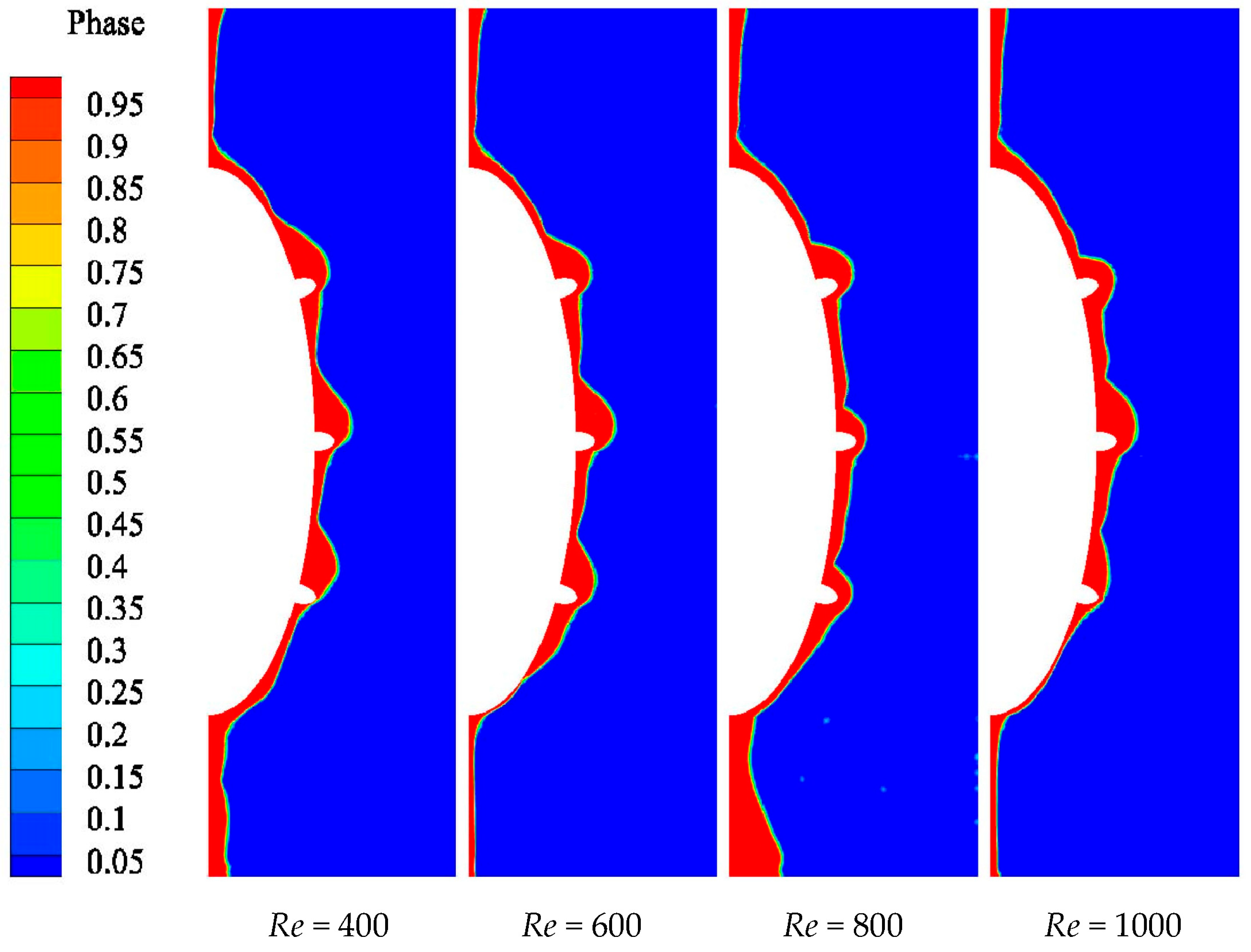


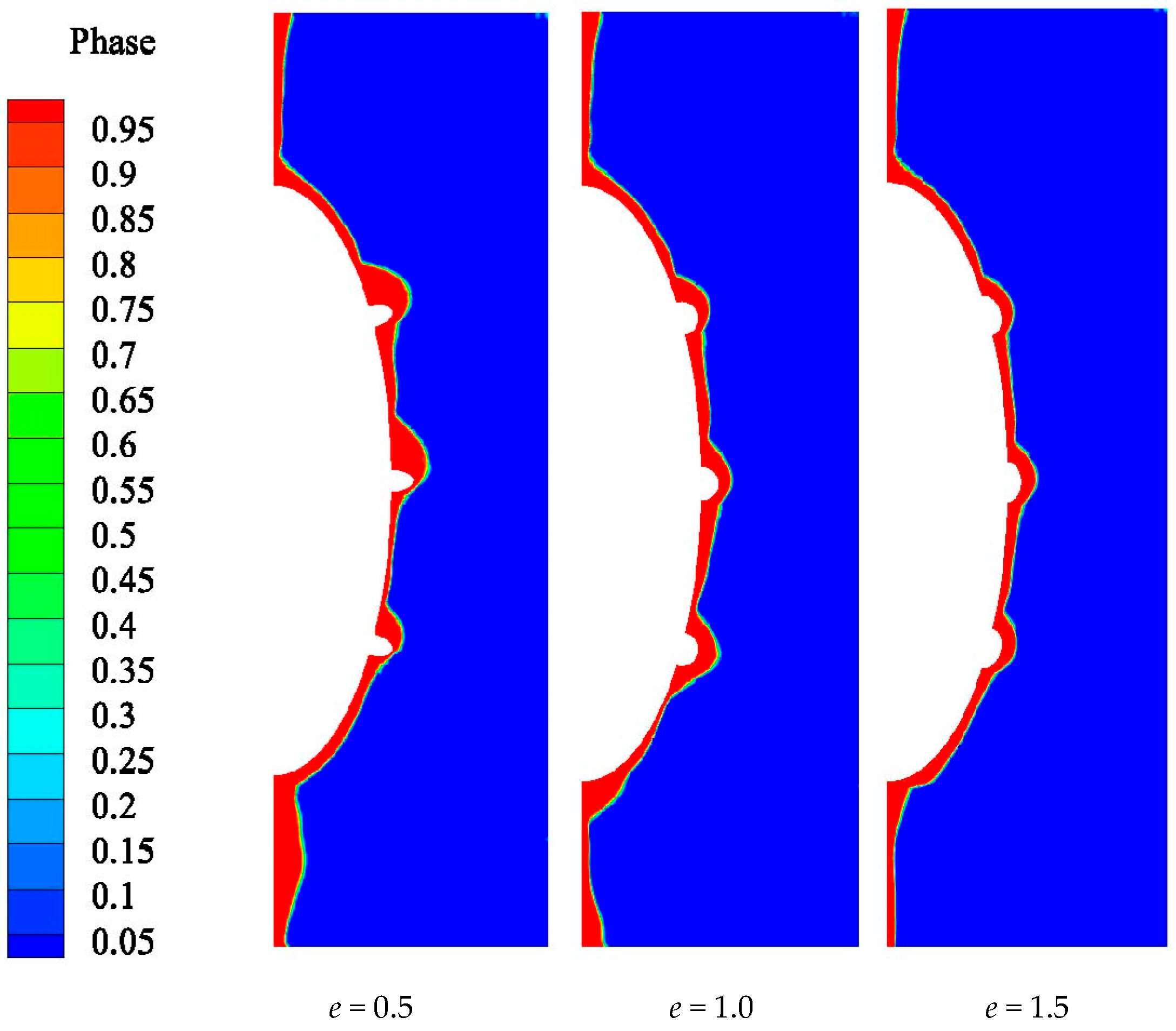


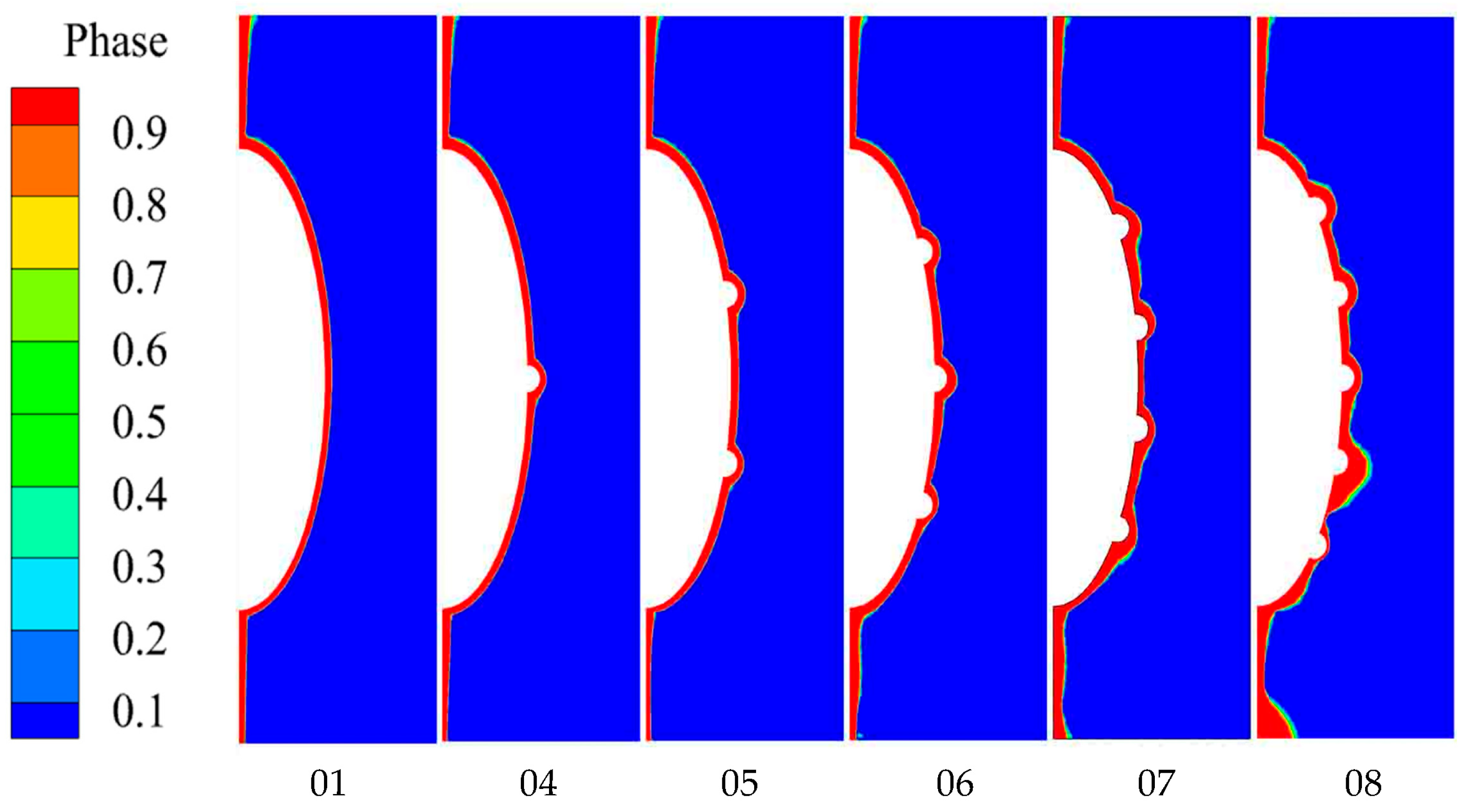

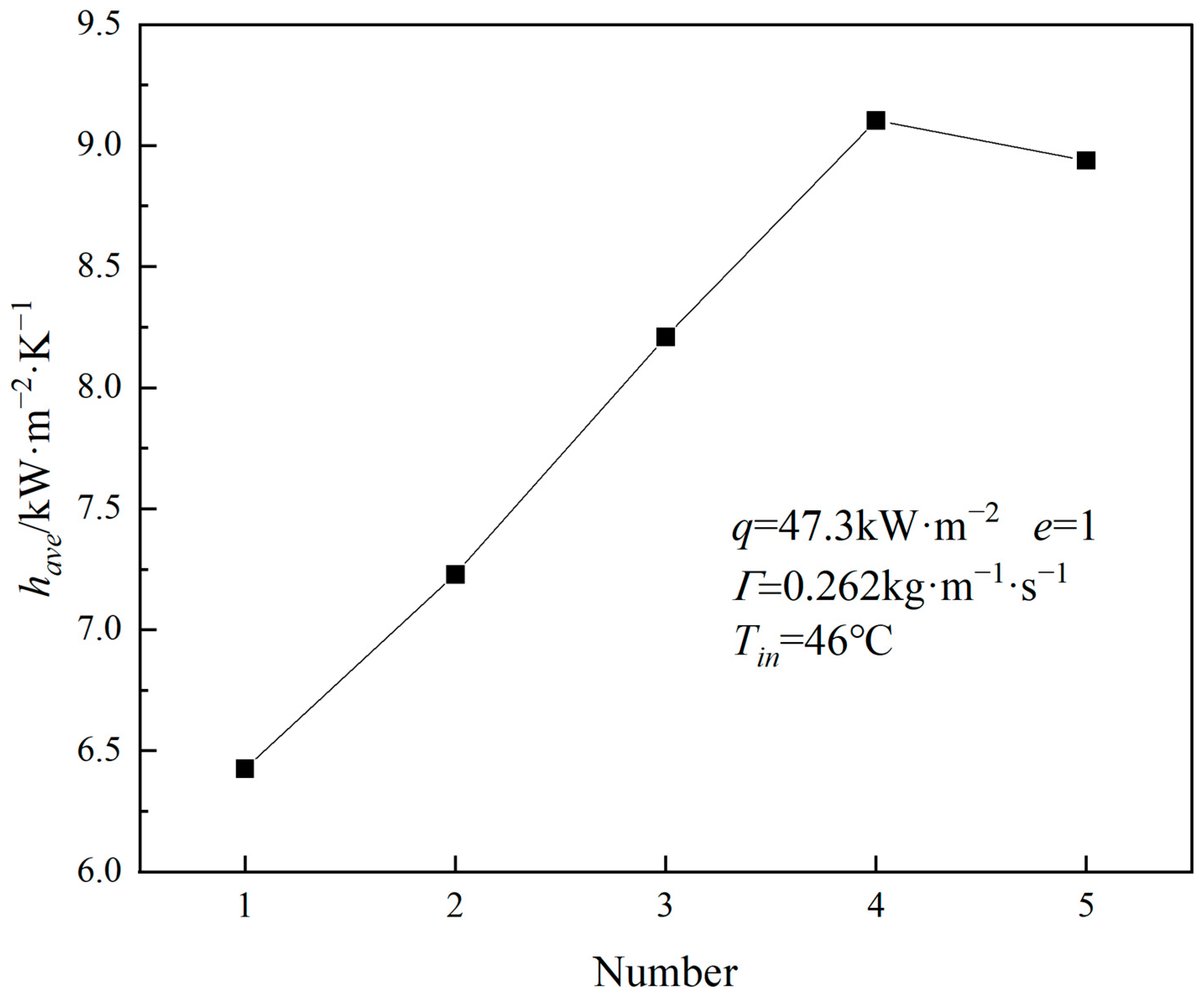
Disclaimer/Publisher’s Note: The statements, opinions and data contained in all publications are solely those of the individual author(s) and contributor(s) and not of MDPI and/or the editor(s). MDPI and/or the editor(s) disclaim responsibility for any injury to people or property resulting from any ideas, methods, instructions or products referred to in the content. |
© 2025 by the authors. Licensee MDPI, Basel, Switzerland. This article is an open access article distributed under the terms and conditions of the Creative Commons Attribution (CC BY) license (https://creativecommons.org/licenses/by/4.0/).
Share and Cite
Lu, Y.; Lu, H.; Zhao, W.; Zheng, C.; Li, Y. Effect of Protrusions on the Falling Film Flow and Heat Transfer of Oily Wastewater Outside an Elliptical Tube. Coatings 2025, 15, 1340. https://doi.org/10.3390/coatings15111340
Lu Y, Lu H, Zhao W, Zheng C, Li Y. Effect of Protrusions on the Falling Film Flow and Heat Transfer of Oily Wastewater Outside an Elliptical Tube. Coatings. 2025; 15(11):1340. https://doi.org/10.3390/coatings15111340
Chicago/Turabian StyleLu, Yiqi, Hao Lu, Wenjun Zhao, Chuanxiao Zheng, and Yajie Li. 2025. "Effect of Protrusions on the Falling Film Flow and Heat Transfer of Oily Wastewater Outside an Elliptical Tube" Coatings 15, no. 11: 1340. https://doi.org/10.3390/coatings15111340
APA StyleLu, Y., Lu, H., Zhao, W., Zheng, C., & Li, Y. (2025). Effect of Protrusions on the Falling Film Flow and Heat Transfer of Oily Wastewater Outside an Elliptical Tube. Coatings, 15(11), 1340. https://doi.org/10.3390/coatings15111340





